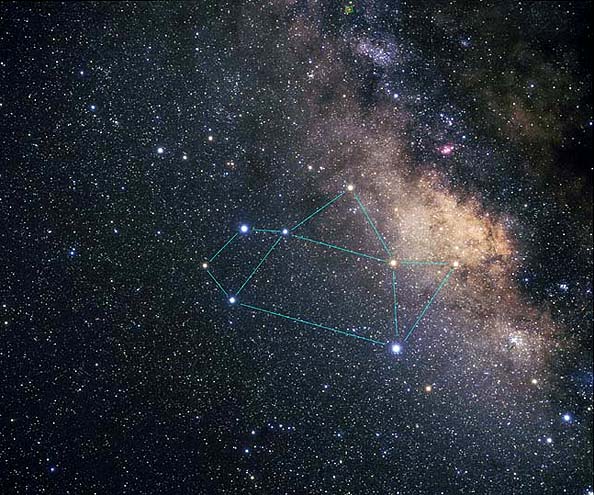Bulge and Nucleus of the Milky Way
|
 |
The above shows the center of the Milky Way galaxy with the
constellation Sagittarius superimposed on the image. The center of the
Milky Way sits just above the spout of the teapot. The bulge sits 27,000
light years from the Earth with coordinates RA = 17h45m40.04s and δ =
-29:00:28.1 (J2000). The bulge is not easily observed in the visible, UV,
or soft x-rays. It is best observed in the γ-ray, hard x-rays, IR,
sub-millimeter, and radio.
The bulge of the Milky Way is more spherical than the disk and is
composed of stars which are more reddish
than those in the disk (===>they are more evolved or low mass, but
are still considered Pop I stars).
The bulge is roughly 30,000 to 40,000 light years in diameter.
The central region of the Galactic Bulge (the nucleus) is
interesting because it shows activity similar to that
shown by
Active Galactic Nuclei, AGNs (although at a
considerably lower level).
- The core harbors ~ 1,600 stars per cubic light year. This is
several 100,000 times as dense as the average stellar density of
our Galaxy! Further, when one approaches the center of the Galaxy, one
finds a dense cluster containing roughly 1 million stars with a stellar
density around 10 million times as high as in the Solar neighborhood.
- Near the center of the Milky Way lies the bright radio source
Sagittarius A.
There is structure on scales ranging from 600 light years
(the filamaents) to what appears to be a
ring of
material on scales of 10-15 light years to structure on scales
of 10 Astronomical Units (~80 light minutes ~ 1.5 billion km)--an
Astronomical Unit is the average distance of the Earth
from the Sun.
- Further observations reveal a bright central object nearly at the
exact center of the Galaxy, Sagittarius A*
.
Just as one can measure galaxy rotation curves
to gain a sense of the mass and mass distribution within galaxies, similar
ideas can be applied to any gravitating system.
- For the galactic center, one may infer the mass for Sgr A*
--(4.1-4.3)x106
Solar masses--and that it is
compact, 0.1 astronomical units, from study of
stars
(SO-2)
near the Galactic center. SO-2 has orbital period - 15.2 years with pericenter
= 17 light hours.
- The shortest period star, SO-102, has period = 11.5 years.
- Sgr A*, typically has small Luminosity,
L = 1036 erg/s. If Sgr A* is powered by
accretion, we have
where S is the mass accretion rate. For the observed L, we expect
S = 1014-15 g/s. Modeling the mass loss from the
stars in the bulge leads to the estimate Sb = 6x1020
g/s. This estimate is >> than that predicted from L.
Suggested that this implies the existence of an
event horizon.
- VLBI sub-millimeter (1.3 mm)
observations (JCMT on Mauna Kea, ARO/SMT on Mt
Graham, AZ, and CARMA array at Cedar Flat, CA) observed Sgr A*
for three consecutive nights in 2009. Detected changes on the third night
consistent with variability on length scales of a few Schwarzschild radius.
- An exciting new instrumental project is the development of the
Event
Horizon Telescope. The Event Horizon Telescope will extend the above
sub-mm (1.3 mm and 0.8 mm)
VLBI experiment by adding the Atacama Large Millimeter/submillimeter
Array (ALMA) in Chile,
the Large Millimeter Telescope (LMT) in Mexico, and the South Pole
Telescope (SPT). Greatly increases the sensitivity of the array, and the
N-S and E-W coverage to increase coverage in the UV plane.

